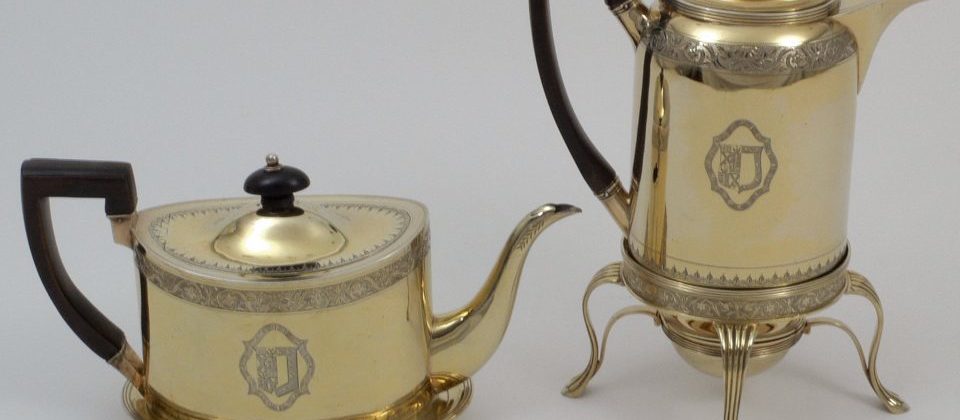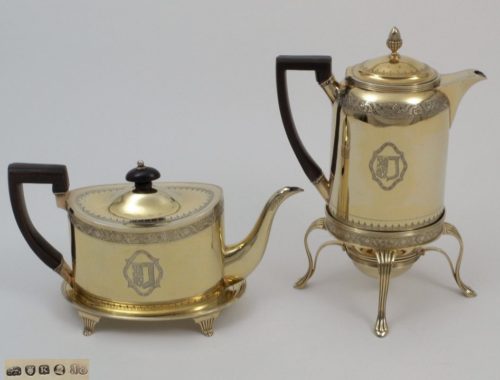Object Number: #503
London 1805/6
Maker: John Emes
City’s hallmark: Lion’s head for London (Jackson 1921: 88)
Sterling silver mark: Lion passant gardant (Jackson 1921: 88)
Date letter: a “K” in a shield for 1805/6 (Jackson 1921: 88)
Duty mark: King’s head in an oval stamp. This mark was on all gold and silver objects assayed in England and Scotland from 01.12.1784 to 30.04.1890. The mark consists of the head of the reigning sovereign in profile, looking to the right of the observer (but the head of Queen Victoria looks to the left) (Jackson 1921: 72 & 88).
Maker’s mark: the initials “JE” in a curved shield for John Emes (Grimwade3: no 1807)
Provenance/Heraldry: Coat of arms Richard Johnstone of Hackness Hall von Yorkshire
Dimensions: Coffee pot with rechaud: height 21.3 cm (8,3 in.); teapot and saucer: height 15 cm (5.9 in.). Weight together. 1.915 gr.
Detailed Information
Antique Silver-Gilt George III Coffeepot on Burner and Teapot on Stand
Coffeepot with rechaud: pot: smooth cylindrical vessel body with short spout. Slightly domed hinged lid with a stylized acorn as a knob. Rectangular wooden handle. On the wall next to a simple flower border that is repeated on the lid, an ornamental band with curled leaves and flowers at shoulder.
The associated rechaud stands on four curved, reeded feet. The ornament of the pot band repeats on the rechaud.
Teapot with stand: oval, cylindrical vessel body with an attached deep sink. Rectangular wooden handle. Oval pedestal on four curved, reeded edges terminating in volutes. The fine engraved ornamental bands repeated on the teapot and the pedestal.
All objects decorate an elaborately engraved coat of arms.
Provenance/Heraldry
The coat of arms for John Stone – Richard Johnstone of Hackness Hall of Yorkshire. In 1795 he was appointed Baron and married in the same year, Margaret, daughter of John Scott. He died in 1807, 75 years old.
Maker
John Emes was presumably son of William Emes of Bowbridge Field, he apprenticed to William Woollett and was free in 1786. His first mark was registered in partnership with Henry Chawner in 1796. In 1798, he registered alone his second and third mark. He was presumably dead by 30 June 1808, when Rebeccah and William Emes entered their mark at the same address.
The work of John Emes consists mostly of tea and coffee-services and demonstrates his taste for an elegant design and a fine execution (Grimwade3: 504).
Literature
Grimwade, Ar., 1990, London Goldsmiths 1697-1837. Their marks and lives from the original registers at Goldsmiths’ Hall and other sources, GB: Faber and Faber [Grimwade3]
Jackson, Ch. J., 1911, An illustrated History of English Plate, ecclesiastical and secular in which the development of form and decoration in the Silver and Gold Work of the British Isles form the earliest known examples to the latest of the Georgian Period, Bd. II, Plauen i. Vogtl.: C.F. Schulz & Co.
Jackson, Ch., J., 1921, English Goldsmiths and their marks, London: MacMillan and Co. Limited



